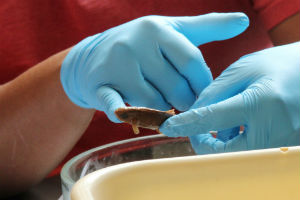The UBC fish collection began formally cataloging specimens in 1945 and has accumulated specimens since before that time (see “History of the Fish Collection” below). More recently and after a massive effort, an inventory of the fish collection has been completed (led by N. Bailly with the assistance of several undergraduate students). As of 2023, the collection contains 26,000 lots with 300,000 specimens (including 1,400 lots and 14,500 specimens still to be cataloged) and over 50,000 DNA and tissue samples. By contrast, the virtual database contains records of 33,700 lots with 346,000 specimens. A “lot” corresponds to one or a set of specimens that were collected at the same location, date, and hour, and with the same gear. Two-thirds of the databased lots come from marine waters, constituting one-third of the number of specimens. The oldest record is a sand lance from the waters of Japan that was collected in 1903. The collection also contains representatives of what may be the youngest fish species on Earth: pairs of stickleback species that evolved only recently in British Columbia’s lakes.
The difference between the number of physically-held lots/specimens and databased lots/specimens stems from donations to other institutions (e.g., 1800 lots were sent to the Canadian Museum of Nature in Ottawa), specimens retained by individual researchers, and, sadly, losses of physical specimens from deterioration. In the latter case, the virtual records of these specimens along with information on habitat, time and season of capture, etc. represent invaluable examples of the “extended specimen.”
In addition, 500 x-ray plates (over 545 recorded for 1,460 specimens), and 129 drawings of many specimens in the collection are available there.
Fishes from British Columbia, the rest of Canada, and the United States account for 75% of the recorded lots. Various expeditions in the Pacific and surrounding Asian countries in the 1950s-60s increased the number of individual species found in the collection to 2,800 species, including 11 holotypes and 209 paratypes for 38 nominal species. Holotype and paratype specimens are the original specimens that were used to describe and name species that were new to science at the time.
The collection has been used in environmental assessments, conservation efforts, and numerous research projects, as well as in educating and training some of Canada’s leading fish biologists. Its specimens have also been used to document regime shifts in the Bering Sea, the formation of new species, and the extinction of others.
The UBC Fish Collection was also the first to be deposited and indexed by FishBase, a web-based relational database containing information on practically all fish known to science. You can search the UBC Fish Collection using FishBase by clicking here. (Once at Fishbase, enter “UBC” under “Begins with” in the “By catalog no.” box; genus and species in the “Name used in collection boxes”, and any other filters you wish and hit “Search”.) For access to pictures, drawings, distribution maps, catch data, graphs of body mass versus brain size, red list status, spawning and size data by geographic area, and much more, click here. The hard copies of collection records with details of each collection have now been scanned and are available through the UBC Library Digital Collection. Click here to view individual collection metadata. You may also find this Field Key to Freshwater BC Fishes (PDF) helpful.
If you would like to access the Fish Collection for research purposes, please contact Dr. Eric Taylor (contact us).
For studies showing how the Fish Collection has been used, please see our Articles & Papers page.
History of the Fish Collection
The UBC Fish Museum started in the mid-1940’s with collections donated by Dr. C. MacLean Fraser, first head of the
Fish Identification Guides
Learn about the diversity and amazingness of BC’s freshwater fishes. Great for educators, anglers, and naturalists.


